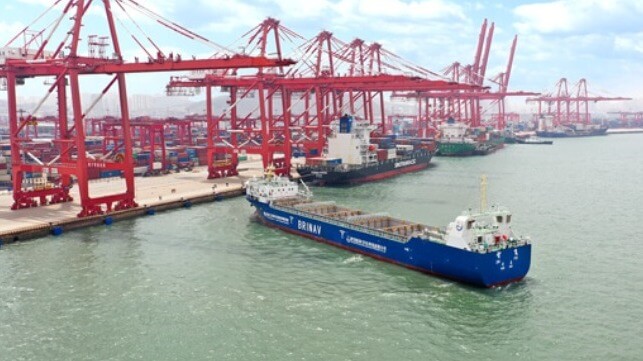Cybersecurity Risk Remains the Leading Concern for Autonomous Shipping

Since the commencement of the EU-backed Maritime Unmanned Navigation through Intelligence in Networks (MUNIN) project, Maritime Autonomous Surface Ship (MASS) technologies, infrastructures, and the overall ecosystem have developed rapidly. Norway has been leading the MASS development race, and the autonomous electric container ship Yara Birkeland has received international attention. Recently, other countries - including Japan, Korea, Finland, the United Kingdom and the United States - have been catching up with MASS development[1].
Levels of autonomy
The International Maritime Organization (IMO) has categorized the levels of autonomy in MASS into four levels. Level 01 is the low degree of autonomy with advanced decision support systems on board, whereas level 04 is fully autonomous ships capable of making decisions themselves. Levels 02 and 03 are semi-autonomous vessels controlled by a remote control center (RCC), the former with a reduced crew and the latter without any crew on board. There are several other classifications, for example, by DNV, Lloyds Register, Bureau Veritas, and American Bureau of Shipping, which in essence refer to identical concepts.
Early autonomous ships are already sailing
My involvement in MASS research over the past five years has led me to witness both sides of the debate over autonomous technology. I have met fierce doubters of MASS quoting serious concerns over safety, job security, regulatory challenges and capital investments. On the other hand, I also had the luxury to see the Yara Birkeland and the two Asko freight ferries operating in the vicinity of my home near Oslofjord.
In an early article published in 2019, I reviewed the related literature and explored potential applications of MASS. The most relevant applications of MASS are in the context of short sea shipping, Arctic shipping routes, and the implementation of vessel platooning[2]. In 2021, my colleagues and I evaluated MASS feasibility in commercial shipping routes. For the present and the near future, Level 02 MASS is the most feasible, particularly in shorter regional routes using smaller vessels[3].
Uptake of autonomous ferries
Following developments in autonomous ships technologies, several autonomous ferry projects are currently underway, particularly Sundbåt, Hyke and milliAmpere in Norway. For the adoption of autonomous passenger ferries, it is essential to understand the perceptions of the public who will take the ferry, even though it meets the safety requirements imposed by authorities. In a recent study, we found that younger people, people with good swimming skills, people who are exposed to the latest technologies, and those using ferries on a monthly basis are more optimistic about taking an autonomous ferry ride[4].
Cyber security risks
While MASS will increase navigational safety in oceans, cyber security risks are likely to increase significantly. We conducted a cyber risk assessment study of five MASS systems and their sub-systems[5]. Navigational systems followed by remote control center and shore-based management offices are most vulnerable to cyber threats. On the sub-system level, Global Navigation Satellite System (GNSS), Electronic Chart Display and Information System (ECDIS), communication devices, Automatic Identification System (AIS), and phishing emails are most vulnerable.
Level 02 MASS in the near future
The consensus from several of my research papers is that the level 2 MASS is the most feasible currently for both commercial shipping and ferry routes as well as for Arctic shipping routes. While autonomy is going to increase safety and reduce operational costs, cyber security risk mitigating approaches need to be explored further. Early deployment of MASS in a commercial context is expected as early as 2023, initially in regional shorter trade-routes. New short-distance routes are likely to emerge through shifting road cargo to sea routes, which will contribute to reducing the environmental impacts of the transport sector. Concerns over seafarers’ jobs may also disappear over time since MASS will merely trigger a shift in job roles rather than the total elimination of seafarers in Level 02 autonomy.
Ziaul Haque Munim is Associate Professor of Maritime Logistics at the Faculty of Technology, Natural and Maritime Sciences at University of South-Eastern Norway.
Footnotes:
[1] Munim, Z. H., & Haralambides, H. (2022). Advances in maritime autonomous surface ships (MASS) in merchant shipping. Maritime Economics & Logistics, 24, pp 181–188.
[2] Munim, Z. H. 2019. Autonomous ships: a review, innovative applications and future maritime business models. Supply Chain Forum: An International Journal, 20 (4), pp. 266-27.
[3] Munim, Z. H., Notteboom, T., Haralambides, H., Schøyen, H. (2021). Feasibility of maritime autonomous surface ships. The Annual conference of the International Association of Maritime Economists (IAME) 2021. November 24-27, 2021. Rotterdam, The Netherlands.
[4] Munim, Z. H., Imset, M., Faury, O., Sukke, M., Kim, H. (2022). Public perception on safety of autonomous ferry in the Norwegian context. The IEEE International Conference on Industrial Engineering and Engineering Management (IEEM) 2022. December 07-10, 2022. Kuala Lumpur, Malaysia.
[5] Tusher, H. M., Munim, Z. H., Notteboom, T. E., Kim, T. E., & Nazir, S. (2022). Cyber security risk assessment in autonomous shipping. Maritime Economics & Logistics, 24, pages 208–227
The opinions expressed herein are the author's and not necessarily those of The Maritime Executive.
